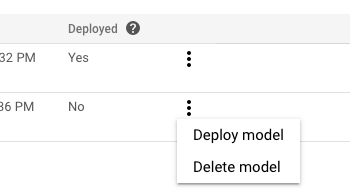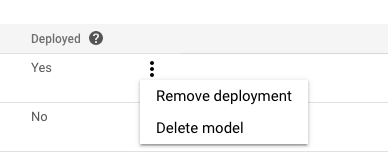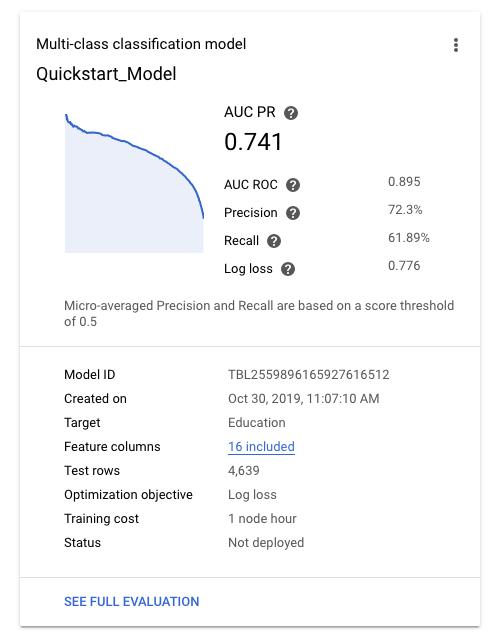本页面介绍如何使用 AutoML Tables 部署、取消部署、列出、删除和获取自定义模型的相关信息。
如需了解如何训练新模型,请参阅训练模型。
部署模型
训练模型后,您必须先部署模型,然后才能使用该模型请求在线预测。可以从未部署的模型请求批量预测。
部署模型会产生费用。如需了解详情,请参阅价格页面。
控制台
转到 Google Cloud 控制台中的 AutoML Tables 页面。
在左侧导航窗格中,选择模型标签页,然后选择区域。
在要部署的模型的更多操作菜单中,点击部署模型。

REST
使用 models.deploy 方法部署模型。在使用任何请求数据之前,请先进行以下替换:
-
endpoint:全球位置为
automl.googleapis.com,欧盟地区为eu-automl.googleapis.com。 - project-id:您的 Google Cloud 项目 ID。
- location:资源的位置:全球位置为
us-central1,欧盟位置为eu。 -
model-id:要部署的模型的 ID。例如,
TBL543。
HTTP 方法和网址:
POST https://endpoint/v1beta1/projects/project-id/locations/location/models/model-id:deploy
如需发送请求,请选择以下方式之一:
curl
执行以下命令:
curl -X POST \
-H "Authorization: Bearer $(gcloud auth print-access-token)" \
-H "x-goog-user-project: project-id" \
-H "Content-Type: application/json; charset=utf-8" \
-d "" \
"https://endpoint/v1beta1/projects/project-id/locations/location/models/model-id:deploy"
PowerShell
执行以下命令:
$cred = gcloud auth print-access-token
$headers = @{ "Authorization" = "Bearer $cred"; "x-goog-user-project" = "project-id" }
Invoke-WebRequest `
-Method POST `
-Headers $headers `
-Uri "https://endpoint/v1beta1/projects/project-id/locations/location/models/model-id:deploy" | Select-Object -Expand Content
您应该收到类似以下内容的 JSON 响应:
{
"name": "projects/292381/locations/us-central1/operations/TBL543",
"metadata": {
"@type": "type.googleapis.com/google.cloud.automl.v1beta1.OperationMetadata",
"createTime": "2019-12-26T19:21:00.550021Z",
"updateTime": "2019-12-26T19:21:00.550021Z",
"worksOn": [
"projects/292381/locations/us-central1/models/TBL543"
],
"deployModelDetails": {},
"state": "RUNNING"
}
}
部署模型是一项长时间运行的操作。您可以轮询操作状态或等待操作返回。了解详情。
Java
如果资源位于欧盟区域,您必须明确设置端点。了解详情。
Node.js
如果资源位于欧盟区域,您必须明确设置端点。了解详情。
Python
AutoML Tables 的客户端库包含其他 Python 方法,这些方法使用 AutoML Tables API 进行简化。这些方法按名称而不是 ID 来引用数据集和模型。您的数据集和模型的名称必须是唯一的。如需了解详情,请参阅客户端参考。
如果资源位于欧盟区域,您必须明确设置端点。了解详情。
取消部署模型
您必须先部署模型,然后才能请求在线预测。如果您不再需要使用模型进行在线预测,可以取消部署该模型以免产生部署费用。
如需了解部署费用,请参阅价格页面。
控制台
转到 Google Cloud 控制台中的 AutoML Tables 页面。
在左侧导航窗格中,选择模型标签页,然后选择区域。
在要取消部署的模型的更多操作菜单中,点击移除部署。

REST
您可以使用 models.undeploy 方法取消部署模型。在使用任何请求数据之前,请先进行以下替换:
-
endpoint:全球位置为
automl.googleapis.com,欧盟地区为eu-automl.googleapis.com。 - project-id:您的 Google Cloud 项目 ID。
- location:资源的位置:全球位置为
us-central1,欧盟位置为eu。 -
model-id:要取消部署的模型的 ID。例如,
TBL543。
HTTP 方法和网址:
POST https://endpoint/v1beta1/projects/project-id/locations/location/models/model-id:undeploy
如需发送请求,请选择以下方式之一:
curl
执行以下命令:
curl -X POST \
-H "Authorization: Bearer $(gcloud auth print-access-token)" \
-H "x-goog-user-project: project-id" \
-H "Content-Type: application/json; charset=utf-8" \
-d "" \
"https://endpoint/v1beta1/projects/project-id/locations/location/models/model-id:undeploy"
PowerShell
执行以下命令:
$cred = gcloud auth print-access-token
$headers = @{ "Authorization" = "Bearer $cred"; "x-goog-user-project" = "project-id" }
Invoke-WebRequest `
-Method POST `
-Headers $headers `
-Uri "https://endpoint/v1beta1/projects/project-id/locations/location/models/model-id:undeploy" | Select-Object -Expand Content
您应该收到类似以下内容的 JSON 响应:
{
"name": "projects/292381/locations/us-central1/operations/TBL543",
"metadata": {
"@type": "type.googleapis.com/google.cloud.automl.v1beta1.OperationMetadata",
"createTime": "2019-12-26T19:19:21.579163Z",
"updateTime": "2019-12-26T19:19:21.579163Z",
"worksOn": [
"projects/292381/locations/us-central1/models/TBL543"
],
"undeployModelDetails": {},
"state": "RUNNING"
}
}
Java
如果资源位于欧盟区域,您必须明确设置端点。了解详情。
Node.js
如果资源位于欧盟区域,您必须明确设置端点。了解详情。
Python
AutoML Tables 的客户端库包含其他 Python 方法,这些方法使用 AutoML Tables API 进行简化。这些方法按名称而不是 ID 来引用数据集和模型。您的数据集和模型的名称必须是唯一的。如需了解详情,请参阅客户端参考。
如果资源位于欧盟区域,您必须明确设置端点。了解详情。
获取模型的相关信息
训练完成后,您可以获取新创建的模型的相关信息。
控制台
转到 Google Cloud 控制台中的 AutoML Tables 页面。
在左侧导航窗格中选择模型标签页,然后选择要查看其信息的模型。
选择训练标签页。
您将看到模型的概要指标,例如精确率和召回率。

若在评估模型质量方面需要帮助,请参阅评估模型。
REST
您可以使用 models.get 方法获取model的相关信息。
在使用任何请求数据之前,请先进行以下替换:
-
endpoint:全球位置为
automl.googleapis.com,欧盟地区为eu-automl.googleapis.com。 - project-id:您的 Google Cloud 项目 ID。
- location:资源的位置:全球位置为
us-central1,欧盟位置为eu。 -
model-id:您要获取相关信息的模型的 ID。例如,
TBL543。
HTTP 方法和网址:
GET https://endpoint/v1beta1/projects/project-id/locations/location/models/model-id
如需发送请求,请选择以下方式之一:
curl
执行以下命令:
curl -X GET \
-H "Authorization: Bearer $(gcloud auth print-access-token)" \
-H "x-goog-user-project: project-id" \
"https://endpoint/v1beta1/projects/project-id/locations/location/models/model-id"
PowerShell
执行以下命令:
$cred = gcloud auth print-access-token
$headers = @{ "Authorization" = "Bearer $cred"; "x-goog-user-project" = "project-id" }
Invoke-WebRequest `
-Method GET `
-Headers $headers `
-Uri "https://endpoint/v1beta1/projects/project-id/locations/location/models/model-id" | Select-Object -Expand Content
您应该收到类似以下内容的 JSON 响应:
Java
如果资源位于欧盟区域,您必须明确设置端点。了解详情。
Node.js
如果资源位于欧盟区域,您必须明确设置端点。了解详情。
Python
AutoML Tables 的客户端库包含其他 Python 方法,这些方法使用 AutoML Tables API 进行简化。这些方法按名称而不是 ID 来引用数据集和模型。您的数据集和模型的名称必须是唯一的。如需了解详情,请参阅客户端参考。
如果资源位于欧盟区域,您必须明确设置端点。了解详情。
列出模型
一个项目可以包含大量模型,这些模型可能是利用相同或不同的数据集训练的。
控制台
如需使用 Google Cloud 控制台查看可用模型的列表,请点击左侧导航栏中的模型标签页,然后选择区域。
REST
要使用 API 查看可用模型的列表,请使用 models.list 方法。
在使用任何请求数据之前,请先进行以下替换:
-
endpoint:全球位置为
automl.googleapis.com,欧盟地区为eu-automl.googleapis.com。 - project-id:您的 Google Cloud 项目 ID。
- location:资源的位置:全球位置为
us-central1,欧盟位置为eu。
HTTP 方法和网址:
GET https://endpoint/v1beta1/projects/project-id/locations/location/models
如需发送请求,请选择以下方式之一:
curl
执行以下命令:
curl -X GET \
-H "Authorization: Bearer $(gcloud auth print-access-token)" \
-H "x-goog-user-project: project-id" \
"https://endpoint/v1beta1/projects/project-id/locations/location/models"
PowerShell
执行以下命令:
$cred = gcloud auth print-access-token
$headers = @{ "Authorization" = "Bearer $cred"; "x-goog-user-project" = "project-id" }
Invoke-WebRequest `
-Method GET `
-Headers $headers `
-Uri "https://endpoint/v1beta1/projects/project-id/locations/location/models" | Select-Object -Expand Content
Java
如果资源位于欧盟区域,您必须明确设置端点。了解详情。
Node.js
如果资源位于欧盟区域,您必须明确设置端点。了解详情。
Python
AutoML Tables 的客户端库包含其他 Python 方法,这些方法使用 AutoML Tables API 进行简化。这些方法按名称而不是 ID 来引用数据集和模型。您的数据集和模型的名称必须是唯一的。如需了解详情,请参阅客户端参考。
如果资源位于欧盟区域,您必须明确设置端点。了解详情。
删除模型
删除模型会将该模型从项目中永久移除。
控制台
在 AutoML Tables 界面中,点击左侧导航菜单中的模型标签页并选择区域,以显示该区域的可用模型的列表。
点击待删除行最右侧的三点状菜单,然后选择删除模型。
在确认对话框中点击删除。
REST
您可以使用 models.delete 方法删除模型。
在使用任何请求数据之前,请先进行以下替换:
-
endpoint:全球位置为
automl.googleapis.com,欧盟地区为eu-automl.googleapis.com。 - project-id:您的 Google Cloud 项目 ID。
- location:资源的位置:全球位置为
us-central1,欧盟位置为eu。 -
model-id:要删除的模型的 ID。例如,
TBL543。
HTTP 方法和网址:
DELETE https://endpoint/v1beta1/projects/project-id/locations/location/models/model-id
如需发送请求,请选择以下方式之一:
curl
执行以下命令:
curl -X DELETE \
-H "Authorization: Bearer $(gcloud auth print-access-token)" \
-H "x-goog-user-project: project-id" \
"https://endpoint/v1beta1/projects/project-id/locations/location/models/model-id"
PowerShell
执行以下命令:
$cred = gcloud auth print-access-token
$headers = @{ "Authorization" = "Bearer $cred"; "x-goog-user-project" = "project-id" }
Invoke-WebRequest `
-Method DELETE `
-Headers $headers `
-Uri "https://endpoint/v1beta1/projects/project-id/locations/location/models/model-id" | Select-Object -Expand Content
您应该收到类似以下内容的 JSON 响应:
{
"name": "projects/29452381/locations/us-central1/operations/TBL543",
"metadata": {
"@type": "type.googleapis.com/google.cloud.automl.v1beta1.OperationMetadata",
"createTime": "2019-12-26T17:19:50.684850Z",
"updateTime": "2019-12-26T17:19:50.684850Z",
"deleteDetails": {},
"worksOn": [
"projects/29452381/locations/us-central1/models/TBL543"
],
"state": "DONE"
},
"done": true,
"response": {
"@type": "type.googleapis.com/google.protobuf.Empty"
}
}
删除模型是一项长时间运行的操作。您可以轮询操作状态或等待操作返回。了解详情。
Java
如果资源位于欧盟区域,您必须明确设置端点。了解详情。
Node.js
如果资源位于欧盟区域,您必须明确设置端点。了解详情。
Python
AutoML Tables 的客户端库包含其他 Python 方法,这些方法使用 AutoML Tables API 进行简化。这些方法按名称而不是 ID 来引用数据集和模型。您的数据集和模型的名称必须是唯一的。如需了解详情,请参阅客户端参考。
如果资源位于欧盟区域,您必须明确设置端点。了解详情。
